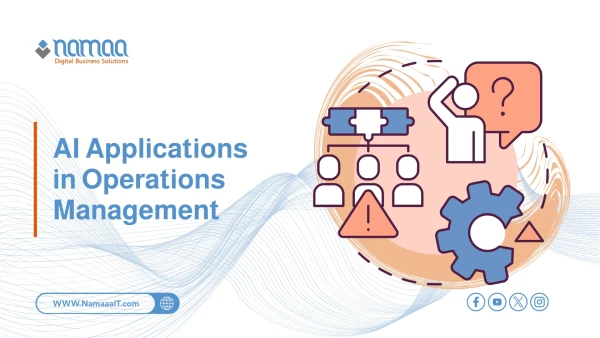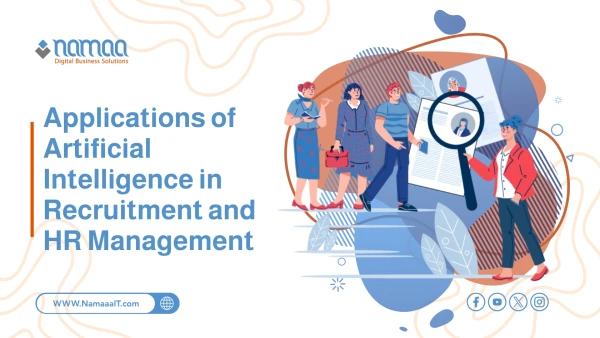Artificial Intelligence: Types, Branches, Applications, Benefits, and Dimensions
Artificial Intelligence (AI) is one of the most prominent technological advancements of the modern era, aiming to enable machines to mimic human capabilities such as learning, thinking, and problem-solving. AI comes in various types based on its capabilities and functions, allowing for a wide range of applications across multiple fields. In this article, we’ll explore the main classifications of AI and its most important practical applications.
What is Artificial Intelligence (AI)?
Artificial Intelligence is one of the most revolutionary fields in the digital age. It refers to the ability of systems and machines to perform tasks that typically require human intelligence, such as understanding, learning, reasoning, problem-solving, and even interacting in natural language. AI is a branch of computer science focused on developing systems that mimic human behavior and can analyze and interact with complex environments in intelligent ways.
At its core, AI relies on advanced algorithms trained on massive amounts of data (Big Data), which enables it to recognize patterns and predict outcomes with high accuracy. As a result, AI technologies have become an integral part of our daily lives, from voice assistants like Siri and Google Assistant to more complex applications such as recommendation systems on Netflix and Amazon, AI-powered medical diagnostics, and even autonomous driving systems.
AI's role goes beyond simplifying repetitive tasks or analyzing data. It also drives innovation in various fields like medicine, education, manufacturing, security, and even the arts. With its continuous development, AI has become the primary engine behind the Fourth Industrial Revolution and is seen as the key to a more efficient and innovative future.
What Are the Four Types of Artificial Intelligence?
AI can be classified into four main categories, varying in terms of development and their ability to simulate human intelligence. This classification helps understand the evolution of AI from simple systems to more advanced, futuristic models still under research and development:
Reactive Machines:
These are the most basic type of AI. They don’t retain memory and cannot use past experiences. They respond only to current inputs and make decisions based on pre-programmed rules. A well-known example is IBM’s “Deep Blue” computer, which defeated world chess champion Garry Kasparov in the 1990s.
Limited Memory:
These systems rely on historical data to make better decisions. They are used in self-driving cars that utilize data such as speed, traffic patterns, and past behaviors to make safe decisions. This type is currently used in many modern AI applications.
Theory of Mind:
This represents a more advanced stage, where AI is expected to understand human emotions, intentions, and beliefs. This type is still in the research phase. If achieved, it would allow machines to interact with humans with emotional intelligence.
Self-Aware AI:
This is the most advanced and theoretical type so far. Self-aware machines would be conscious of their own existence and understand their emotions and those of others. No system of this kind exists yet, but research in this area is ongoing.
What Are the Branches of Artificial Intelligence?
AI consists of several specialized branches, each playing a specific role in enhancing intelligent systems and their real-life applications. These branches form the foundation of thousands of applications we use today:
Machine Learning (ML):
The most well-known AI branch, it is based on the idea that systems can learn from data and improve performance over time without direct human intervention. It’s used in fields like market analysis, image recognition, recommendation engines, and more.
Deep Learning:
An extension of machine learning, it relies on artificial neural networks made up of multiple layers that mimic how the human brain works. It’s used in advanced applications like automatic translation, facial recognition, and voice recognition.
Natural Language Processing (NLP):
This branch focuses on enabling machines to understand and generate human language. Common applications include machine translation, chatbots, and sentiment analysis.
Computer Vision:
Aims to give systems the ability to see and interpret images and videos. It’s used in autonomous vehicles, security surveillance systems, and media content analysis.
Robotics:
Combines AI with mechanical engineering to design machines that can perform complex tasks such as manufacturing, disaster response, and interacting with humans.
Fuzzy Logic:
Used for decision-making in environments with imprecise or variable data—such as smart air conditioning systems or washing machines—where exact values alone are not enough.
Together, these branches form the core structure of modern AI systems, illustrating how data can be transformed into knowledge, and knowledge into actionable, intelligent decisions.
Learn about: Types of Artificial Intelligence
What Are the Most Popular Applications of AI?
Recent years have seen significant advancements in AI applications, integrating them into many aspects of our daily lives. Some of the most notable applications include:
Virtual Assistants:
Like Apple’s Siri, Google Assistant, and Amazon Alexa, which rely on natural language processing technologies to provide information and execute voice commands.
Content Generation Tools:
Such as ChatGPT, which helps writers and companies generate consistent and contextually relevant text quickly and efficiently.
Image and Video Editing:
Apps like Photoleap and Lensa use AI to enhance images and add artistic effects.
Education and Learning:
Apps like Duolingo and Socratic offer interactive learning experiences powered by AI.
Healthcare and Medical Diagnostics:
Machine learning algorithms are used to analyze medical images and predict diseases, helping doctors provide more accurate diagnoses.
Autonomous Vehicles:
These use AI to understand their surroundings and make driving decisions without human intervention.
These examples demonstrate the vast range of AI applications across different fields, contributing to improved efficiency and the delivery of innovative solutions.
Benefits and Risks of Artificial Intelligence
AI offers many benefits, including:
Reducing Human Errors:
Thanks to its precision in data processing, AI reduces errors caused by human factors.
Performing Dangerous Tasks:
AI-powered robots can operate in hazardous environments such as space exploration or handling dangerous chemicals, keeping humans safe.
Enhancing Efficiency and Productivity:
AI automates repetitive processes, allowing humans to focus on creative and strategic tasks.
However, there are potential risks:
High Costs:
Developing and maintaining AI systems requires significant financial investment, which may be a barrier for small businesses.
Increased Unemployment:
Replacing human labor with automation could lead to job losses in some sectors.
Security and Privacy Concerns:
AI systems depend on large amounts of data, raising concerns about the protection and potential misuse of personal information.
Therefore, it’s essential to strike a balance between reaping the benefits of AI and addressing its potential challenges.
What Are the Dimensions of Artificial Intelligence?
AI is not just a single technology—it is a multi-dimensional field encompassing a range of concepts and subdomains that come together to create intelligent systems capable of performing complex tasks. Key dimensions of AI include:
Cognitive Dimension:
Focuses on enabling machines to mimic human mental abilities like perception, logical thinking, and decision-making. This involves developing algorithms that allow systems to process and understand information in human-like ways.
Learning Dimension:
Refers to systems' ability to learn from data and experience, known as Machine Learning. This dimension allows AI to improve over time without needing to be reprogrammed. It also includes Deep Learning, which uses neural networks to replicate brain-like thinking.
Communication Dimension:
Deals with AI’s ability to interact with humans in their natural language through techniques such as NLP, language generation, and speech recognition. This is what makes smart assistants and chatbots more effective and fluid.
Social and Ethical Dimension:
We cannot overlook the social and ethical dimensions of artificial intelligence, which focus on how AI impacts societies and individuals in terms of fairness, privacy, bias, and ethical responsibility. This aspect has become central in modern discussions about the development of AI and ensuring its responsible and sustainable use.
Summary:
✅ The four types of artificial intelligence include: Reactive Machines, Limited Memory, Theory of Mind, and Self-Aware.
✅ AI is used in various daily applications: More than 77% of the devices we use rely on artificial intelligence either directly or indirectly, such as voice assistants, smart filters, and recommendation apps for shopping and entertainment.
✅ AI offers high productivity efficiency: Studies indicate that using AI in business can increase productivity by up to 40% and help companies reduce operational costs by as much as 30%.
✅ 3 out of 5 jobs may be affected by AI in the future: According to the World Economic Forum report, around 60% of current jobs are expected to be directly impacted by automation and AI technologies in the coming years.
✅ More than 80% of major companies rely on AI: In 2024, 83% of leading global companies used AI solutions in data analysis, customer service, and strategic decision-making.
✅ Growing focus on ethical considerations: Over 72% of tech experts believe that laws and regulations must be enforced to govern AI usage, especially regarding privacy, employment, and automated decision-making.
 Home
Let's think together
Articles
About
Contact Us
عربي
عربي
Home
Let's think together
Articles
About
Contact Us
عربي
عربي
.webp)






.webp)
